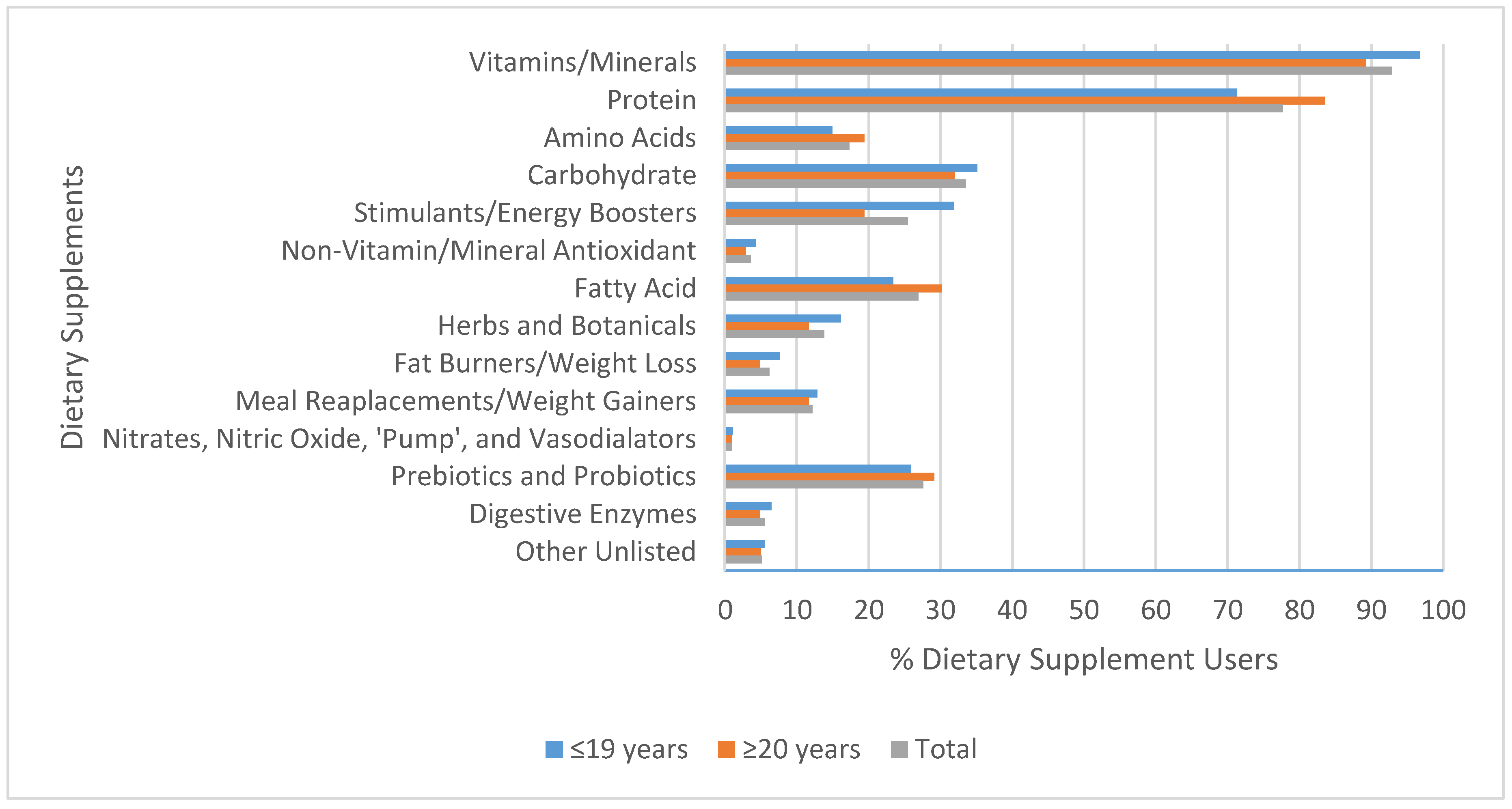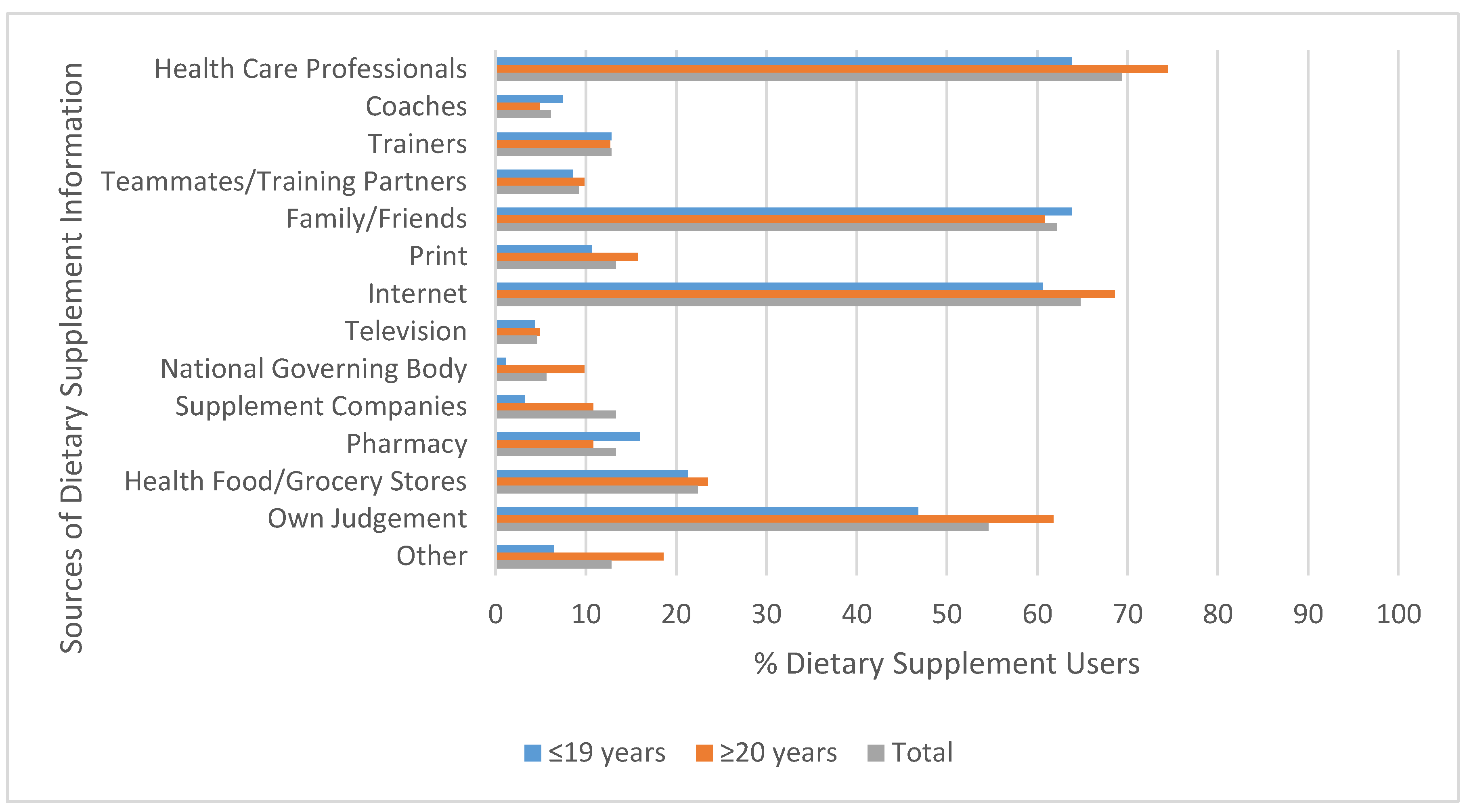Dietary Supplement Use among Non-athlete Students at a Canadian University: A Pilot-Survey
Abstract
:1. Introduction
2. Materials and Methods
2.1. Participants and Recruitment
2.2. Questionnaire Development and Design
2.3. Statistical Analysis
3. Results
3.1. Participant Characteristics
3.2. Prevalence of Supplementation
3.3. Types of Dietary Supplements
3.4. Frequency and Duration of Use
3.5. Reasons for Dietary Supplement Use Source of Information
3.6. Nutrition Labels and Negative Side Effects
3.7. Non-Dietary Supplement Use
3.8. Participants’ Learning Interest
4. Discussion
5. Conclusions
Supplementary Materials
Author Contributions
Funding
Acknowledgments
Conflicts of Interest
References
- Baltazar-Martins, G.; Brito de Souza, D.; Aguilar-Navarro, M.; Muñoz-Guerra, J.; Plata, M.D.M.; del Coso, J. Prevalence and Patterns of Dietary Supplement Use in Elite Spanish Athletes. J. Int. Soc. Sports Nutr. 2019, 16, 30. [Google Scholar] [CrossRef] [PubMed] [Green Version]
- 2019 CRN Consumer Survey on Dietary Supplements: Consumer Intelligence to Enhance Business Outcomes. Available online: www.crnusa.org/2019survey (accessed on 19 May 2020).
- Binns, C.W.; Lee, M.K.; Lee, A.H. Problems and Prospects: Public Health Regulation of Dietary Supplements. Annu. Rev. Public Health 2018, 39, 403–420. [Google Scholar] [CrossRef] [PubMed] [Green Version]
- Dietary Supplement Health and Education Act of 1994 Public Law 103-417 103rd Congress. Available online: https://ods.od.nih.gov/About/DSHEA_Wording.aspx#sec3 (accessed on 23 July 2020).
- Dietary Supplement Products & Ingredients. Available online: https://www.fda.gov/Food/DietarySupplements/ProductsIngredients/default.htm (accessed on 19 June 2020).
- About Natural Health Products. Available online: https://www.canada.ca/en/health-canada/services/dcccccrugs-health-products/natural-non-prescription/regulation/about-products.html (accessed on 19 June 2020).
- Health Fact Sheets Use of Nutritional Supplements. 2015. Available online: https://www.statcan.gc.ca/pub/82-625-x/2017001/article/14831-eng.htm (accessed on 19 June 2020).
- Valentine, A.A. Dietary Supplement Use, Perceptions, and Associated Lifestyle Behaviors in Undergraduate College Students, Student-Athletes, and ROTC Cadets. Master’s Thesis, Illinois State University, Normal, IL, USA, May 2015. [Google Scholar]
- Begdache, L.; Kianmehr, H.; Heaney, C.V. College Education on Dietary Supplements May Promote Responsible Use In Young Adults. J. Diet. Suppl. 2020, 17, 67–80. [Google Scholar] [CrossRef]
- Lieberman, H.R.; Marriott, B.P.; Williams, C.; Judelson, D.A.; Glickman, E.L.; Geiselman, P.J.; Dotson, L.; Mahoney, C.R. Patterns of Dietary Supplement Use among College Students. Clin. Nutr. 2015, 34, 976–985. [Google Scholar] [CrossRef] [Green Version]
- Guo, X.; Willows, N.; Kuhle, S.; Jhangri, G.; Veugelers, P.J. Use of Vitamin and Mineral Supplements among Canadian Adults. Can. J. Public Health 2009, 100, 357–360. [Google Scholar] [CrossRef]
- Valentine, A.A.; Schumacher, J.R.; Murphy, J.; Ma, Y.J. Dietary Supplement Use, Perceptions, and Associated Lifestyle Behaviors in Undergraduate College Students, Student-Athletes, and ROTC Cadets. J. Am. Coll. Health 2018, 66, 87–97. [Google Scholar] [CrossRef] [Green Version]
- Johnson, S.K.; Blanchard, A. Alternative Medicine and Herbal Use Among University Students. J. Am. Coll. Health 2006, 55, 163–168. [Google Scholar] [CrossRef]
- Perkin, J.E.; Wilson, W.J.; Schuster, K.; Rodriguez, J.; Allen-Chabot, A. Prevalence of Nonvitamin, Nonmineral Supplement Usage among University Students. J. Am. Diet. Assoc. 2002, 102, 412–414. [Google Scholar] [CrossRef]
- Bailey, R.L.; Gahche, J.J.; Miller, P.E.; Thomas, P.R.; Dwyer, J.T. Why US Adults Use Dietary Supplements. JAMA Intern. Med. 2013, 173, 355–361. [Google Scholar] [CrossRef] [Green Version]
- Marra, M.V.; Bailey, R.L. Position of the Academy of Nutrition and Dietetics: Micronutrient Supplementation. J. Acad. Nutr. Diet. 2018, 118, 2162–2173. [Google Scholar] [CrossRef] [Green Version]
- Guallar, E.; Stranges, S.; Mulrow, C.; Appel, L.J.; Miller, E.R. Enough Is Enough: Stop Wasting Money on Vitamin And. Ann. Intern. Med. 2013, 159, 850–851. [Google Scholar] [CrossRef]
- Barry, A.R. Patients’ Perceptions and Use of Natural Health Products. Can. Pharm. J. 2018, 151, 254–262. [Google Scholar] [CrossRef] [PubMed]
- Nichter, M.; Thompson, J.J. For My Wellness, Not Just My Illness: North Americans’ Use of Dietary Supplements. Cult., Med. Psychiatry 2006, 30, 175–222. [Google Scholar] [CrossRef] [PubMed]
- Kandel, D.B. Stages and Pathways of Drug Involvement: Examining the Gateway Hypothesis; Cambridge University Press: Cambridge, UK, 2002. [Google Scholar]
- Hurst, P.; Kavussanu, M.; Boardley, I.; Ring, C. Sport Supplement Use Predicts Doping Attitudes and Likelihood via Sport Supplement Beliefs. J. Sports Sci. 2019, 37, 1734–1740. [Google Scholar] [CrossRef]
- Yager, Z.; O’Dea, J.A. Relationships between Body Image, Nutritional Supplement Use, and Attitudes towards Doping in Sport among Adolescent Boys: Implications for Prevention Programs. J. Int. Soc. Sports Nutr. 2014, 11, 1–8. [Google Scholar] [CrossRef] [PubMed] [Green Version]
- Martínez-Sanz, J.M.; Sospedra, I.; Ortiz, C.M.; Baladía, E.; Gil-Izquierdo, A.; Ortiz-Moncada, R. Intended or Unintended Doping? A Review of the Presence of Doping Substances in Dietary Supplements Used in Sports. Nutrients 2017, 9, 93. [Google Scholar] [CrossRef] [PubMed] [Green Version]
- Geyer, H.; Parr, M.K.; Koehler, K.; Mareck, U.; Schnazer, W.; Thevis, M. Nutritional Supplements Cross-Contaminated and Faked with Doping Substances. J. Mass Spectrom. 2008, 43, 1342–1347. [Google Scholar] [CrossRef] [PubMed]
- de Hon, O.; Coumans, B. The Continuing Story of Nutritional Supplements and Doping Infractions. Br. J. Sports Med. 2007, 41, 800–805. [Google Scholar] [CrossRef] [Green Version]
- Baume, N.; Mahler, N.; Kamber, M.; Mangin, P.; Saugy, M. Research of Stimulants and Anabolic Steroids in Dietary Supplements. Scand. J. Med. Sci. Sports 2006, 16, 41–48. [Google Scholar] [CrossRef]
- Geller, A.I.; Shehab, N.; Weidle, N.J.; Lovegrove, M.C.; Wolpert, B.J.; Timbo, B.B.; Mozersky, R.P.; Budnitz, D.S. Emergency Department Visits for Adverse Events Related to Dietary Supplements. N. Engl. J. Med. 2015, 373, 1531–1540. [Google Scholar] [CrossRef]
- Natural Health Product Tracking Survey–2010 Final Report. Available online: http://epe.lac-bac.gc.ca/100/200/301/pwgsc-tpsgc/por-ef/health/2011/135-09/report.pdf (accessed on 19 June 2020).
- Jackson, J.; Lyons, T.S.; Roberts, J.L.; Geary, C.; Williams, J. Use of Nutritional Supplementation Among University Recreation Users. Recreat. Sports J. 2010, 34, 2–8. [Google Scholar] [CrossRef]
- Vatanparast, H.; Adolphe, J.L.; Whiting, S.J. Socio-Economic Status and Vitamin/Mineral Supplement Use in Canada. Health Rep. 2010, 21, 19. [Google Scholar] [PubMed]
- Snyder, F.J.; Dundas, M.L.; Kirkpatrick, C.; Neill, K.S. Use and Safety Perceptions Regarding Herbal Supplements: A Study of Older Persons in Southeast Idaho. J. Nutr. Elder. 2009, 28, 81–95. [Google Scholar] [CrossRef] [PubMed]
- Troppmann, L.; Johns, T.; Gray-Donald, K. Natural Health Product Use in Canada. Can. J. Public Health Rev. Can. de Sante Publique 2002. [Google Scholar] [CrossRef]
- Fact Book 2018–2019. Available online: https://www.uoguelph.ca/iar/sites/default/files/Fact%20Book%202018-2019.pdf (accessed on 23 July 2020).
- El Khoury, D.; Dwyer, J.J.M.; Fein, L.; Brauer, P.; Brennan, S.; Alfaro, I. Understanding the Use of Dietary Supplements among Athlete and Non-Athlete University Students: Development and Validation of a Questionnaire. Sports 2019, 7, 166. [Google Scholar] [CrossRef] [Green Version]
- International Physical Activity Questionnaire. Available online: https://sites.google.com/site/theipaq/home (accessed on 19 June 2020).
- Stelmach, M. Physical activity assessment tools in monitoring physical activity: The Global Physical Activity Questionnaire (GPAQ), the International Physical Activity Questionnaire (IPAQ) or accelerometers–choosing the best tools. Health Probl. Civiliz. 2018, 12, 57–63. [Google Scholar] [CrossRef]
- Global Strategy on Diet, Physical Activity and Health. Available online: https://www.who.int/dietphysicalactivity/factsheet_adults/en/ (accessed on 23 July 2020).
- Dickinson, A.; Mackay, D. Health Habits and Other Characteristics of Dietary Supplement Users: A Review. Nutr. J. 2014, 13, 1–8. [Google Scholar] [CrossRef] [Green Version]
- Canadian Community Health Survey, Cycle 2.2, Nutrition. Available online: https://www.canada.ca/en/health-canada/services/food-nutrition/food-nutrition-surveillance/health-nutrition-surveys/canadian-community-health-survey-cchs/canadian-community-health-survey-cycle-2-2-nutrition-focus-food-nutrition-surveillance-health-canada.html (accessed on 19 June 2020).
- Rodriguez, N.R.; DiMarco, N.M.; Langley, S. Position of the American Dietetic Association, Dietitians of Canada, and the American College of Sports Medicine: Nutrition and Athletic Performance. J. Am. Diet. Assoc. 2009, 109, 509–527. [Google Scholar] [CrossRef]
- Canadian Community Health Survey–Nutrition: Nutrient Intakes from Food and Nutritional Supplements. Available online: https://www150.statcan.gc.ca/n1/daily-quotidien/170620/dq170620b-eng.htm (accessed on 19 June 2020).
- Kårlund, A.; Gómez-Gallego, C.; Turpeinen, A.M.; Palo-Oja, O.M.; El-Nezami, H.; Kolehmainen, M. Protein Supplements and Their Relation with Nutrition, Microbiota Composition and Health: Is More Protein Always Better for Sportspeople? Nutrients 2019, 11, 829. [Google Scholar] [CrossRef] [Green Version]
- El Khoury, D.; Antoine-Jonville, S. Intake of Nutritional Supplements among People Exercising in Gyms in Beirut City. J. Nutr. Metab. 2012. [Google Scholar] [CrossRef]
- Whey Protein. Available online: https://www.mayoclinic.org/drugs-supplements-whey-protein/art-20363344 (accessed on 17 June 2020).
- Bailey, R.L.; Fulgoni, V.L.; Keast, D.R.; Dwyer, J.T. Examination of Vitamin Intakes among US Adults by Dietary Supplement Use. J. Acad. Nutr. Diet. 2012, 112, 657–663.e4. [Google Scholar] [CrossRef] [PubMed] [Green Version]
- Payette, H.; Gray-Donald, K. Do Vitamin and Mineral Supplements Improve the Dietary Intake of Elderly Canadians? Can. J. Public Health 1991, 82, 58–60. [Google Scholar] [PubMed]


| Characteristics | Prevalence |
|---|---|
| Supplement Use (n = 475) | |
| Yes | 43.4% |
| No | 56.6% |
| Participant Age (n = 456) | |
| Mean ± SD: | 20.1 ± 1.8 |
| Range | 18–31 |
| Age Groups (n = 456) | |
| ≤ 19 | 59.4% |
| ≥ 20 | 40.6% |
| Gender (n = 464) | |
| Female | 88.1% |
| Male | 11.2% |
| Other/Prefer not to disclose | 0.6% |
| Ethnicity (n = 475) | |
| Caucasian | 77.5% |
| South East Asian | 8.0% |
| South Asian | 6.7% |
| West Asian | 0.2% |
| Black | 4.4% |
| Indigenous | 2.3% |
| Latin | 2.3% |
| Arab | 2.1% |
| Prefer not to disclose | 1.1% |
| Other | 2.9% |
| Parents’/Guardians’ | |
| Education (n = 475) | |
| Bachelors | 34.3% |
| Diploma | 28.8% |
| College | 27.4% |
| High School | 17.3% |
| No Diploma | 2.7% |
| Other Education | 1.9% |
| Activity Status (n = 461) | |
| Active | 96.3% |
| Sedentary | 3.7% |
| Variable | n | B | S.E. | Significance | Exp(B) | 95% C.I. for EXP(B) | |
|---|---|---|---|---|---|---|---|
| Lower | Upper | ||||||
| Age | 475 | 0.569 | 0.172 | 0.001 | 1.766 | 1.262 | 2.472 |
| Parent/Guardians’ Education | 461 | 0.162 | 0.053 | 0.002 | 1.176 | 1.060 | 1.305 |
| Gender | 461 | 0.583 | 0.297 | 0.050 | 1.791 | 1.001 | 3.203 |
| Alcohol | 425 | 0.287 | 0.239 | 0.229 | 1.333 | 0.835 | 2.128 |
| Smoking | 435 | 0.458 | 0.613 | 0.456 | 1.580 | 0.475 | 5.259 |
| Ethnicity | 463 | −0.003 | 0.036 | 0.934 | 0.997 | 0.929 | 1.070 |
| Activity Status | 461 | 0.103 | 0.502 | 0.837 | 1.109 | 0.414 | 2.965 |
© 2020 by the authors. Licensee MDPI, Basel, Switzerland. This article is an open access article distributed under the terms and conditions of the Creative Commons Attribution (CC BY) license (http://creativecommons.org/licenses/by/4.0/).
Share and Cite
El Khoury, D.; Hansen, J.; Tabakos, M.; Spriet, L.L.; Brauer, P. Dietary Supplement Use among Non-athlete Students at a Canadian University: A Pilot-Survey. Nutrients 2020, 12, 2284. https://doi.org/10.3390/nu12082284
El Khoury D, Hansen J, Tabakos M, Spriet LL, Brauer P. Dietary Supplement Use among Non-athlete Students at a Canadian University: A Pilot-Survey. Nutrients. 2020; 12(8):2284. https://doi.org/10.3390/nu12082284
Chicago/Turabian StyleEl Khoury, Dalia, Joel Hansen, Madelyn Tabakos, Lawrence L. Spriet, and Paula Brauer. 2020. "Dietary Supplement Use among Non-athlete Students at a Canadian University: A Pilot-Survey" Nutrients 12, no. 8: 2284. https://doi.org/10.3390/nu12082284






